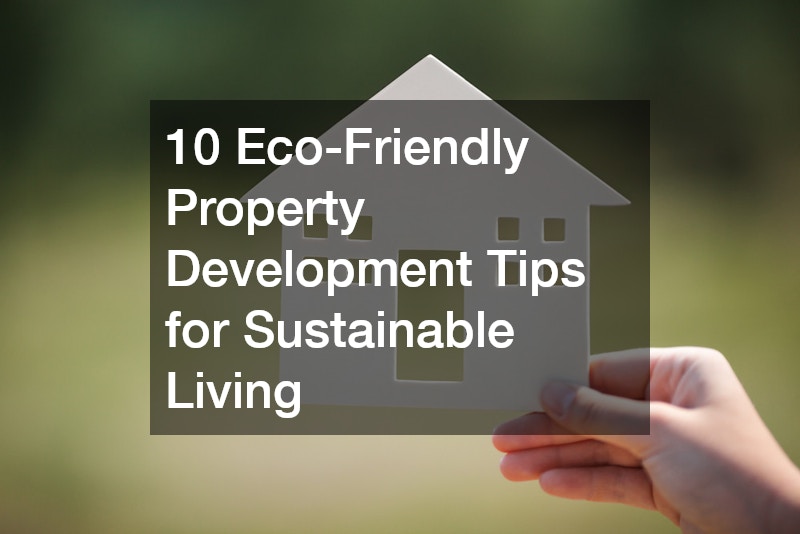
10 Eco-Friendly Property Development Tips for Sustainable Living
As the effects of climate change continue to be felt globally, the need for sustainable living practices is more critical than ever. One of the areas where individuals and businesses can make a significant impact is through eco-friendly property development. By prioritizing sustainability, not only do we contribute positively to the environment, but we also create healthier and more energy-efficient spaces for ourselves and future generations.
Eco-friendly property construction encompasses a wide range of practices aimed at reducing the ecological impact of construction and renovation projects. From implementing energy-efficient technologies to using sustainable building materials, the principles of eco-friendly property development promote a balance between development and the preservation of our natural resources. Furthermore, as consumers become more eco-conscious, properties that prioritize sustainability often maintain higher market values and lower operational costs.
In this blog, we’ll discuss ten actionable tips for eco-friendly property development that not only enhance sustainability but also bring long-term benefits. Whether you are a seasoned developer or a homeowner looking to remodel your property, these strategies will help you embrace eco-friendly practices. The following tips cover various aspects of property development, ensuring that you can find innovative solutions that work for your specific needs.

1. Choose Sustainable Building Materials
A fundamental aspect of eco-friendly property development is the selection of sustainable building materials. Opt for materials that are renewable, recyclable, and locally sourced to minimize transportation emissions. Bamboo, reclaimed wood, and recycled steel are excellent examples that reduce resource depletion while being durable.
When selecting materials, it’s essential to consider the entire lifecycle of the products—from extraction and processing to end-of-life disposal. This approach ensures that the materials do not contribute negatively to the environment throughout their usage. By partnering with home remodeling contractors who prioritize sustainable sourcing, you can further ensure that your project aligns with eco-friendly standards. For instance, if you’re planning a roofing replacement, consider the lifespan of the materials you choose and how they are produced. This can make a significant impact on your ecological footprint.
Additionally, using low-VOC (volatile organic compounds) paints and finishes mitigates indoor air pollution, contributing to healthier living spaces. This choice is especially important in areas frequently remodeled, such as kitchens and bathrooms. Overall, choosing sustainable materials is crucial for both eco-friendly property construction and long-term property viability. Take time to review the materials that will be used, whether for bathroom remodeling or landscaping – it matters.
2. Invest in Energy-Efficient Technologies
Incorporating energy-efficient technologies is vital for reducing energy consumption and lowering building operational costs. This includes investing in energy-efficient appliances, smart thermostats, and insulation materials that decrease the need for heating and cooling. For instance, tankless water heaters offer the benefit of hot water on demand without the energy loss associated with traditional storage water heaters.
Solar panels are another excellent investment that promotes sustainability in eco-friendly property development. They harness renewable energy from the sun, significantly reducing reliance on fossil fuels. By utilizing renewable energy sources, homeowners can not only save on energy bills but also contribute to a cleaner environment.
Additionally, energy-efficient technologies can include solar water heating systems and energy-efficient windows that don’t just reduce electricity bills; they also enhance the overall comfort of living spaces. When exploring these upgrades, consult with local excavating contractors who understand the installation of such features for optimal efficiency and performance. As you make these investments, consider enlisting the expertise of professionals who can identify the most suitable options for your property’s specific needs.

3. Implement Water Conservation Practices
Water conservation is a key aspect of sustainable living, and it can be easily integrated into eco-friendly property construction. Installing water softeners can improve the efficiency of plumbing systems and appliances while using less soap and detergent, thereby reducing waste. In addition, these devices can extend the lifespan of fixtures and appliances, saving homeowners money in the long run.
Homeowners and developers should also consider installing rainwater harvesting systems to capture and reuse rainwater for irrigation and flushing toilets. This system works particularly well for properties located in areas prone to heavy rainfall. Furthermore, integrating xeriscaping principles—a landscaping approach that reduces or eliminates the need for irrigation—can greatly decrease water usage and promote biodiversity.
Employing drought-resistant plants and sustainable landscaping practices can enhance the ecosystem of your property while also contributing to aesthetic appeal. Collaborating with a tree trimming service can help manage trees in a way that promotes healthy growth without compromising water resources. Overall, these practices not only conserve water but also create a more resilient landscaping layout.
4. Optimize Indoor Air Quality
Indoor air quality is crucial for the health and well-being of occupants, making it an essential consideration in eco-friendly property development. Poor air quality can lead to various health issues, making air purification systems and proper ventilation necessary for any sustainable property. Mold remediation companies can assist in detecting and removing mold, ensuring that the indoor environment remains safe and healthy.
Additionally, choosing building materials that do not off-gas harmful chemicals is vital for maintaining clean air indoors. Using low-VOC paints, non-toxic finishes, and high-grade filters can significantly contribute to a healthier indoor environment. Beyond materials, integrating natural ventilation strategies, such as strategically placed windows and air vents, allows fresh outdoor air to circulate freely.
Incorporating plants into indoor spaces can also enhance air quality naturally. They remove toxins and improve oxygen levels, creating a more pleasant atmosphere overall. Encouraging occupants to maintain these living spaces effectively can also include regular cleaning and inspection routines that engage local septic tank repairs or other maintenance services when necessary.

5. Design Flexible Spaces
One effective strategy in eco-friendly property construction is to design flexible spaces that can adapt to the changing needs of occupants. This approach not only maximizes the functional use of space but also reduces the need for expansions that can have significant environmental impacts. Open floor plans or modular furniture can facilitate a creative and inclusive living atmosphere without requiring extensive remodeling.
When planning your property layout, consider multi-functional rooms that can serve various purposes, such as a home office that can easily convert to a guest room. This flexibility decreases long-term construction needs and encourages a sustainable lifestyle without excessive resource consumption. Hiring home remodeling contractors who specialize in versatile designs can ensure that you get the best functionality from your space.
Additionally, planning for future upgrades and renovations can prevent the need for complete overhauls further down the line. For example, an easily accessible bathroom can later be remodeled to accommodate elderly residents or visitors, saving resources and time. Ultimately, designing flexible spaces improves property value while supporting sustainable living practices.
6. Use Renewable Energy Sources
The adoption of renewable energy sources is a cornerstone of eco-friendly property development. Utilizing solar energy through the installation of solar panels not only decreases utility costs but also promotes cleaner air by reducing dependency on fossil fuels. This investment can provide substantial returns over time as technologies continue to advance and energy prices fluctuate.
Wind turbines and geothermal heating are also viable options depending on your geographic location. Harnessing these renewable energy sources can augment your property’s sustainability profile and potentially lead to energy independence. It’s advisable to consult with local excavating contractors to explore these options, ensuring proper installation in line with local regulations.
Furthermore, hybrid systems that combine multiple renewable sources can provide added reliability and efficiency. For instance, coupling solar and wind energy can balance seasonal energy generation variations. By integrating renewable technologies into your property, you actively contribute to a sustainable future that benefits not only you but also your community and the environment.

7. Consider Smart Home Technologies
The rise of smart home technologies has revolutionized the way we interact with our living spaces, making eco-friendly property construction more accessible than ever. Smart devices can monitor and control various functions, such as lighting, temperature, and energy consumption, which ultimately leads to more efficient living. Investing in smart thermostats, lighting, and even smart irrigation systems can enhance not only comfort but also sustainability.
Additionally, these technologies can provide valuable data regarding energy usage, allowing occupants to make informed decisions about their consumption habits. By analyzing energy reports from smart meters, homeowners can identify opportunities for reducing waste and improving efficiency. Engaging with home remodeling contractors familiar with smart technologies can further streamline your process in integrating these features.
Smart home technologies also promote a higher level of convenience, which can encourage occupants to embrace eco-friendly practices. For example, automated timers can ensure that lights and devices are turned off when not in use, directly impacting energy savings. Overall, the integration of smart technologies is a modern approach to achieving sustainable living in your development project.
8. Plan for Sustainable Landscaping
Landscaping plays a crucial role in eco-friendly property development, and responsible landscaping choices can significantly impact both the environment and a property’s aesthetic appeal. Prioritizing native plants that are well adapted to local climates can reduce water usage and maintenance needs while supporting local ecosystems. Moreover, strategic landscaping can improve energy efficiency by providing shade during warmer months and allowing sunlight in during winter.
Landscaping can also involve using pervious materials for walkways and driveways to minimize stormwater runoff and promote groundwater replenishment. Working with a paving contractor who understands these principles can ensure that you achieve sustainable hardscaping solutions. When landscaping projects are combined with tree trimming services, you enable healthier plants that contribute to reduced heating and cooling costs.
Additionally, composting initiatives can foster sustainable landscaping by repurposing organic waste from your property. Encouraging biodiversity through wildlife gardens can also provide habitats for local fauna, enhancing the overall ecological integrity of your property. Sustainable landscaping is a vital element of eco-friendly property development, improving environmental impact and property value simultaneously.
9. Address Infrastructure and Utility Needs Wisely
Effective management of infrastructure and utility needs is imperative for eco-friendly property development. This includes assessing existing utility systems such as sewage and water supply and determining when upgrades or replacements are necessary. Utilizing local septic tank repairs can promote the responsible management of waste, preventing potential health hazards and environmental contamination.
Furthermore, prioritizing utility efficiency not only reduces costs but can also significantly lower a property’s environmental footprint. This could involve evaluating the efficiency of existing plumbing and electrical systems and integrating modern solutions that comply with eco-friendly standards. Engaging with experienced local excavating contractors during this process ensures compliance and effectiveness in infrastructure improvements.
As you undertake infrastructure improvements, consider implementing systems that monitor usage and encourage conservation. These upgrades contribute to sustainability while also ensuring that your property remains functional and competitive in the market. The synergetic approach to utility management can create a solid foundation for maintaining sustainability throughout the life of the property.
10. Educate Occupants on Sustainable Practices
Developing eco-friendly properties is only half the equation; educating occupants about sustainable practices is equally essential. When residents understand the benefits of energy conservation, waste reduction, and sustainable living, they are more likely to embrace these changes. Hosting informational sessions or providing materials that highlight eco-friendly practices can positively impact a property’s overall sustainability.
Engage residents by creating an environment that encourages community involvement related to sustainability initiatives on the property. Organizing activities such as community composting or tree planting can foster a sense of responsibility and ownership among occupants. Incorporating these educational practices creates a supportive culture that extends the benefits of your eco-friendly property development.
Share resources related to local services, such as local septic tank repairs or mold remediation companies, to assist occupants in making environmentally sound choices. By empowering individuals with knowledge and tools, you cultivate a community committed to sustainability. The cumulative effect of individual actions leads to significant environmental benefits when occupants work together harmoniously.
11. Reduce Construction Waste
Minimizing construction waste is a crucial step in sustainable property development. The construction industry generates significant amounts of waste, much of which ends up in landfills. Implementing waste reduction strategies can help lower the environmental impact of your project.
One effective way to manage waste is through deconstruction instead of demolition. Salvaging materials such as doors, windows, bricks, and fixtures for reuse can significantly cut down on waste while saving costs. Additionally, recycling construction debris, including concrete and metal, reduces the demand for virgin materials. Partnering with waste management companies that specialize in construction recycling can further streamline the process.
Another key consideration is ordering materials with precise measurements to minimize excess and repurposing offcuts for smaller projects or decorative features. Sustainable waste management practices ensure that construction and renovation projects contribute to a circular economy, reducing overall environmental harm.
12. Promote Sustainable Transportation Options
Sustainable property development extends beyond the buildings themselves to the surrounding infrastructure and transportation options. Encouraging environmentally friendly transportation methods can significantly lower a property’s carbon footprint and enhance overall sustainability.
One way to promote sustainable transport is by incorporating bike-friendly infrastructure, such as secure bike storage and dedicated pathways. Additionally, ensuring access to public transportation and designing walkable communities can reduce the need for car usage, thereby cutting down on emissions.
For residential developments, installing electric vehicle (EV) charging stations is an excellent way to future-proof properties while supporting clean energy initiatives. Encouraging ride-sharing programs or providing incentives for eco-friendly commuting methods can also foster a culture of sustainability among occupants.
By integrating these transportation considerations into your development plans, you can create a property that not only supports sustainable living but also enhances convenience and quality of life for its residents.
The principles of eco-friendly property development extend beyond mere aesthetic choices; they encompass a holistic approach that prioritizes sustainability in every aspect of property construction and management. From selecting sustainable materials and implementing energy-efficient technologies to fostering community education and involvement, the decisions that we make today deeply influence our environmental legacy. As property developers, homeowners, and community members, the responsibility to adopt eco-friendly practices lies with us all.
By employing the tips outlined in this article, you can make significant strides toward sustainable living, both personally and professionally. Understanding the various facets of eco-friendly property development will empower you to create thriving, resilient communities that coexist harmoniously with nature. As we face mounting challenges related to climate change, embracing these practices within property development is not just beneficial—it’s imperative for the survival and prosperity of our planet.
Ultimately, the journey toward sustainable living is an ongoing process, and every small change can lead to substantial improvements. Engage with trusted professionals like home remodeling contractors, tree trimming services, and local excavating contractors to implement these eco-friendly practices in your property development projects effectively. Together, we can pave the way for a greener future that prioritizes the health of both the environment and its inhabitants.

